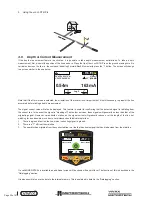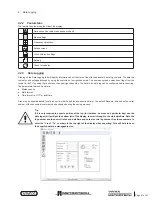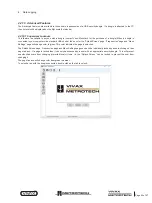
™
Page 33 of 67
3 Using the vLoc3 RTK-Pro
3.9 Distorted Fields
When locating, always be aware that you are locating the signals radiating from the buried line, these radiated fields, as they are
called, can be distorted by other lines or electromagnetic signals from buried lines or metallic features like crash barriers or wire
mesh fences.
As seen previously, the vLoc3 RTK-Pro has the ability to detect the presence of possible distortion, i.e. the Vector screen has a
circle drawn around the target line which increases in size in the presence of possible distortion, and the Plan view screen has
“Tram” lines either side of the calculated position which move further from the line as possible distortion is detected. However,
when using the traditional screen, the risk of an inaccurate location can be reduced further by the following:
●
Check to see if the signal is being distorted by other radiated fields. Locate the cable, first in the “Peak” mode, and then in
the “Null” mode (or use the left/righty arrows). The two locations should indicate that the cable is in the same place. If they
do not, the signal field is distorted, and the depth and current measurement may be inaccurate.
2
1
3
1
Null Position
2
True Position
3
Peak Position
●
Measure the depth of the buried line by pressing “i” pushbutton briefly to measure depth and current. The depth should be
approximately in line with the “as-built” plans available. If no plans are available logic would still help to assess the situation
(for instance, if you are looking for a shallow CCTV distribution cable and the depth indicated is 5ft (1.5m) it should raise a
concern).
●
Take a depth reading on the ground and then raise the locator approximately 1ft or 0.25m and repeat the depth
measurement. The depth should increase by this amount, if not treat the information with caution.
●
A depth reading on congested areas or close to bends or tees may be inaccurate due to distorted fields.
d
d
d
d
d
















































